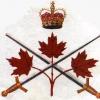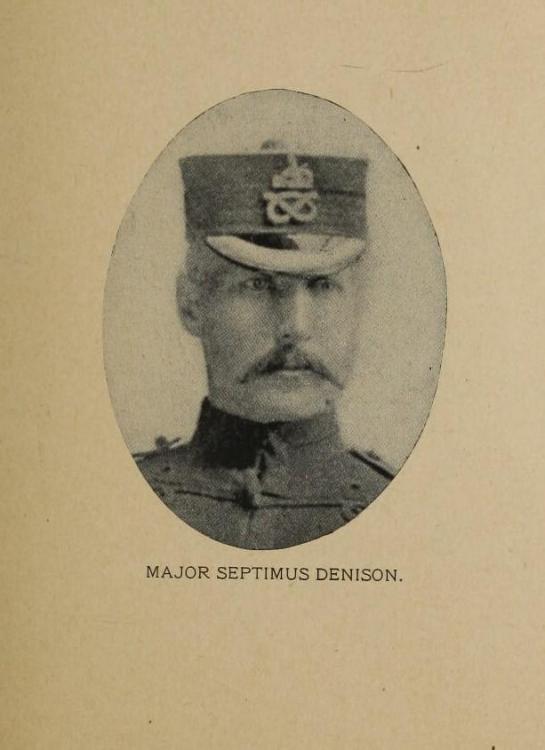-
Posts
29 -
Joined
-
Last visited
Contact Methods
-
MSN
martel500@gmail.com
-
Yahoo
degmartel@rogers.com
Profile Information
-
Gender
Male
-
Location
Mississauga
Dan M's Achievements
-
Rick, i think you're assumption is closer to the mark then what has been presented. During my time in the RCR, none of our uniforms were marked according to the Company we were in, but all had labels with the size sewn on the inside. Ink markings were no longer used. I must admit however, that I was never issued with a set of Scarlets. Also, the lettering of the Companies within the Regiment from A (Duke's Company) to T came about in the early 1970's. Prior to that the Rifle Companies in each battalion were lettered from A to D. Although I'm not an expert, I think the tunic with the patch pockets is an earlier pattern than the one without. The most knowledgeable person about the RCR I know is Michael O"Leary who runs the RCR history website The Regimental Rogue. He may be able to help you more than anyone else. Cheers, Dan.
-
Robert, A bit more from my friend: I've read the NAA files on both Jillett and Graves. It appears I was wrong. Graves did do some time in New Guinea and appears that he was involved in "Jungle Craft' of some sort. I still don't rate him. My friend also asked if you would like a photo of Greendale Station which was the Jillett property and / or the Tambo war memorial which will have Jillett recorded on it. Cheers, Dan. Glad you liked it. Thanks for the accolade. Dan.
-
Robert, I reached out to my favourite antipodean amateur historian who is the most knowledgeable person I know concerning the Australian military. It's his opinion that Richard Graves tales of rescue and his magic unit are exaggerations of the worst order. Which is probably why you can't find any viable authority mentioning it... or him. I quote: "A generation of Australian Boy Scouts grew up with Graves' Bushcraft books in the 70's. I was one of them. I haven't done it in a while but I reckon I can still whittle up a 'four pattern' snare trigger. When I was 14, Dad was posted to Canungra. Canungra was then the Jungle Training Centre and had been since WW2. By then I was a senior scout, called Venturers in Oz. Scouts were based at a place called Fogarty's Farm which was also the jungle survival school run in those days by Billy Bostock. Later Bill's role was taken up by Les Hidden's who became a bit of a TV star. That was well after my time by which the school had transferred to Tully in Far North Queensland. We learned a lot. I was taught Jungle Nav by Clem Ebner who'd been teaching it for decades. Even so, I got regularly lost (and still do) in the McPherson Ranges, with perfect maps, awesome compasses and a tally counter to measure paces. Billy Bostock taught us to make fish traps and spears. All based on indigenous skills and crafts. It was pretty much that experience that convinced me that Dick Graves was full of and had most likely never set foot in Triple Canopy Rainforest in his life. Pretty much nothing in his bushcraft books is relevant to Jungle. What I do know about Graves is that he was a WW1 Gallipoli Veteran. I know from the WW2 nominal roll that he was demobbed as a lieutenant in early 1945 from the 111th Tank Attack Regiment, a unit that never left Australia. A couple of things. A detachment of 60 to the USAF from the Australian Army is going to be commanded by a Major at the very least. You need a field grade officer to be responsible for Administration and Discipline. Goes double for when working with foreign forces. Graves is a bit light on in the rank department. Apart from Graves' forward to his bushcraft books I've never seen any other reference to a 'jungle rescue' unit. Which is not to say that USAF airmen were not occasionally rescued by Australians. Technically they were not 'rescued' by Australians, they were rescued by locals and the Australians facilitated their extraction because they had radios. This was done in the Pacific by Coastwatcher's and in PNG by ANGAU. Peter Ryan's "Fear Guide my Feet" is the seminal ANGAU work. Even then, before the advent of helicopters, extraction was difficult. In the Pacific it could be done by Catalina in New Guinea by Flying Boat if a big enough River was handy. The prospect of walking out by ill equipped and possibly injured aircrew was and is still a non-starter. See here. By WW2 the Australian Army had determined that the key to Jungle Survival was harnessing local indigenous knowledge. Graves knew nothing of this."
-

2nd Lieut W.G. Butteriss, MC, MM
Dan M replied to cazack's topic in Great Britain: Orders, Gallantry, Campaign Medals
Crossed swords indicates war service. Not restricted to just the Great War, but includes any of the small wars prior. I'm going to take a guess and say W.S./Lt. stands for War Service Lieutenant meaning he received a commission for the duration of the War only. Cheers, Dan. -
Note that in the photo of Maj SJA Denison, he is wearing a Staffordshire Knot badge on his cap rather than the badge of the RCRI. As a young man, after leaving RMC, Denison went to England and was commissioned into a militia battalion, the 1st Staffordshire Regiment which, after the Childers reforms, became the 4th Bn, The South Staffordshire Regiment. He eventually rose to the rank of Major. Denison went to South Africa as an officer with the RCRI, however it looks like when he was taken on as an ADC to Field Marshal Roberts, he re-badged himself to his militia battalion, the South Staffs. From what i can see from his record, he was in the British Army militia and the Canadian militia concurrently. Major was the highest rank Denison achieved in the British Army. Cheers, Dan.
-

Badge for what
Dan M replied to dedehansen's topic in Great Britain: Militaria: Badges, Uniforms & Equipment
I'm guessing The Burma Rifles (1917-1948). They had a male peacock in their cap and collar badges. But if it's dated to 1898, then there's no way It also has a Guelphic crown, as used by The Rifle Brigade until 1910 and adopted again in 1955-1966. What Indian regiment was aligned with The Rifle Brigade in the 19th century? Cheers, Dan. -

6th Airborne Epaulette Loops
Dan M replied to AndyGPR's topic in Great Britain: Research, Documentation & History
You're missing, or the original diagram was missing, the gold loop worn by the 1st Canadian Parachute Battalion. Did the original identify the colours? There's three blues and two greens. Cheers, Dan. PS: Was there no loop identified for the 12th Devonshires? -

WW II - What's this helmet?
Dan M replied to Hugh's topic in Great Britain: Militaria: Badges, Uniforms & Equipment
It's a Mk III also known as the invasion helmet. It was issued, along with the Mk II as worn by the other soldier in your photo, to the troops who took part in the Normandy invasion. Check out this site from the IWM: http://www.iwm.org.uk/collections/item/object/30101243 Cheers, Dan. -
Peter, Thanks for the response and the link. Always interested to learn something I hadn't been aware of prior. The period I'm interested in is the time of the organization of The Light Infantry in 1968. I'd mentioned it earlier in post #4, but I can see now how I could have made my post clearer. Supposedly there were four different versions of drill, particularly rifle drill, utilized by the four regiments. Creating a common drill for the new regiment was one of the issues to be resolved along with the items of dress, badges, etc. For the life of me I can't think of how different the individual drill was. I think the differences may have been exxagerated, but I've never been able to find any information on it. Again, thanks for the link. Cheers, Dan.
-
jf42, I think that this is about as much of answer as I will ever get on the subject. Thanks for taking the time to respond. I would tend to agree that it was probably the Shorncliffe-Light Infantry-Sir John Moore connection that led to the Green Jackets Brigade taking the form it did. Now, if you can explain to me please, why all of the different LI regiments had such diverse rifle drill movements, and what these drill movements were, I would again be most grateful. Cheers, Dan.
-
Thanks for the reply jf42. Very informative. Back in the mists of time I recall reading about the light and grenadier companies created during the 18th century but, with increasing interests taking up more of my limited brain space, it must have slipped away. Knowledgeable as you are, maybe you could help me with another question I have from the post-war period. When the administrative Green Jacket Brigade was formed in 1948 why was it the Oxs & Bucks LI were chosen as one of its regiments? The OBLI wasn't the most senior or junior of the LI regiments, nor was it more closely linked to the rifle regiments than the others. Would you have any thoughts on this? Thanks. Cheers, Dan.



